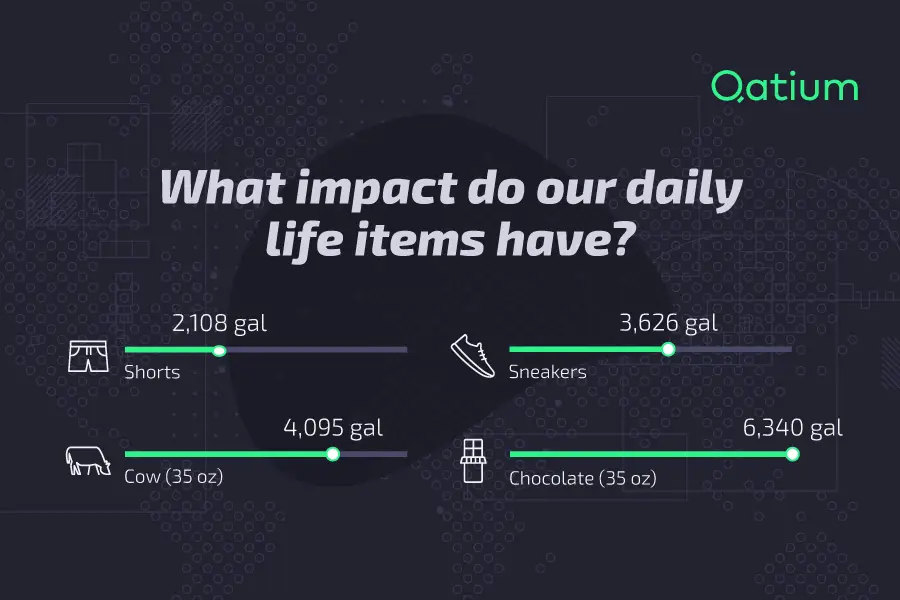Without water there is no life, or at least not as we used to know it. We live on this blue planet, and if it’s special among a vast, inert outer space, it is because it fulfills the necessary conditions to support life. All cells, both animal and plant, contain a large amount of water, about 75%. And these cells need large amounts of water for their survival. Without a doubt, water is an essential element that is part of everything, and it shapes the world as we know it. Thus, we have to talk about the water footprint.
Why is the water footprint so important?
What’s the meaning of water footprint?
Fresh water is the most used natural resource in the products we consume daily. But, do we know how much water is necessary to produce each of these foods? This is where the concept of water footprint sheds light and clears doubts about the amount of water used for each product.
Researchers at the University of Twente (Netherlands), Arjen Hoekstra and Mesfin Mekonnen, developed this concept in 2002. Their objective was to show the impact, in water quantity that everyday objects have.

In the current context of climate change and population increase there is big pressure on water resources. This means that access to fresh water is decreasing seriously and continuously. Currently, the lack of resources affects 4 out of 10 people, and by 2025 it may affect 67% of the population. For this reason, it is necessary to become aware of the importance of water. Reducing the use of resources to improve the ability to adapt to a complex future is essential.
Marc Buckley is member of the Innovation & Agriculture, Food & Beverage Expert Network of the World Economic Forum and one of the greatest advocates of the 17 UN Sustainable Development Goals (SDG). He assures that, “Water is the most valuable resource we have”. This is because the resource is crosscutting and directly or indirectly affects all SDGs. For this reason, solving the problems related to the lack of quality water would improve the current situation of every SDG.
Currently, lack of resources affects 4 out of 10 people,
Qatium
but in 2025 it may affect 67% of the population
Intelligent Assistant
How can we calculate the water footprint?
The water footprint of a product is the amount of water that is consumed and/or polluted at all stages of production. It is measured in units of volume (liters, cubic meters, gallons…), giving an idea of the impact that a certain article has on the use of fresh water. Therefore, it takes into account the water used directly in production, and the indirect part used in its raw materials.
For example, if we want to measure the water footprint of 2 lb. of beef, we might consider not only the water consumed by the animal, but also the water needed to produce the food and the water polluted in the process. After that we might add the water that is necessary to transport the meat to the supermarket, the one used to keep it refrigerated, etc.
Categories Of The Water Footprint
There are three categories based on the origin of water used in manufacturing a product. This is the proposal Professor Hoekstra made in 2008 on the Water Footprint Network:
- Green water footprint: the precipitation and evaporation of water that is used in manufacturing a product. In the case of a rice field, it would be the rainfall directly falling on the field and the portion that evaporates.
- Blue water footprint: the surface or underground water from natural or artificial sources regulated by facilities or infrastructure. It is usually the biggest portion in most products. In the case of a rice field, it would be the water to irrigate from ditches or pumping.
- Gray water footprint: the amount of resources necessary to assimilate the pollution produced during the manufacturing process. In the case of a rice field, it would be the necessary water that the environment needs to assimilate the chemical products used during production (fertilizers, herbicides, pesticides, etc.).

The water footprint of coffee is approximately 52 gallons per cup.
How can we reduce our water footprint?
The famous phrase of 19th century British physicist-mathematician William Thomson Kelvin highlights the importance of measuring to improve any process:
““I often say that when you can measure what you are speaking about, and express it in numbers, you know something about it; but when you cannot measure it, when you cannot express it in numbers, your knowledge is of a meagre and unsatisfactory kind; it may be the beginning of knowledge, but in your brain, you have scarcely advanced to the state of Science, whatever the matter may be.”
Lord Kelvin, 1883
For this reason, the first step in reducing the water footprint is to know and calculate it.
But there are additional recommendations to reduce the water footprint:
- Reduce the consumption of certain products. For example, consume more fruits, vegetables, and fresh food.
- Consume local products. Buying from local farmers reduces the indirect water impact of the product.
- Do not purchase non-seasonal products. Storing or importing products increases the product’s water footprint.
- Avoid wasting food. Buy responsibly.
- Boost and promote circular economy to reduce water consumption and pollution. Reusing and reducing consumption has a positive impact in reducing the use of water resources.
- Promote the responsible use of water. For example, avoid taking baths and promote taking showers.
- Drink tap water. Bottled water has a bigger environmental impact than tap water.









